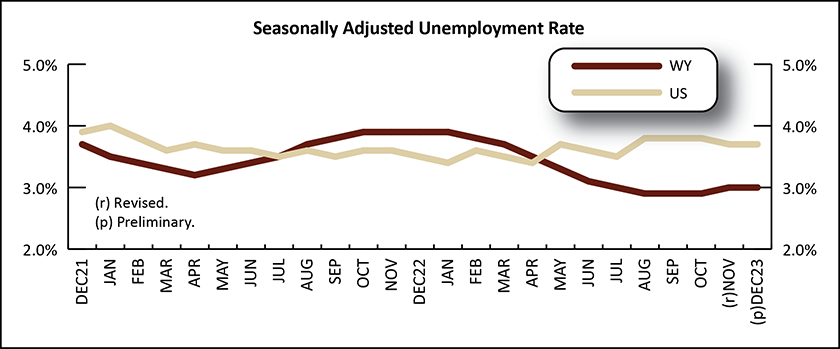Wyoming Labor Force Trends
February 2024 | Volume 61, No. 2
Click Here for PDF
Return to Table of Contents
Wyoming Unemployment Unchanged at 3.0% in December 2023
by: David Bullard, Senior Economist
The Research & Planning section of the Wyoming Department of Workforce Services reported that the state’s seasonally adjusted1 unemployment rate remained unchanged from November to December at 3.0%. Wyoming’s unemployment rate was considerably lower than its December 2022 level of 3.9% and lower than the current U.S. unemployment rate of 3.7%.
From November to December, unemployment rates decreased in every county. It is somewhat unusual to see county unemployment rates fall in December. The largest decreases occurred in Teton (down from 3.7% to 2.0%), Hot Springs (down from 2.9% to 2.2%), Uinta (down from 3.4% to 2.8%), Goshen (down from 2.8% to 2.2%), and Albany (down from 2.7% to 2.1%) counties.
From December 2022 to December 2023, unemployment rates fell in every county, suggesting that the state’s labor market continues to tighten. The largest decreases occurred in Carbon (down from 4.1% to 2.7%), Washakie (down from 3.9% to 2.6%), Sweetwater (down from 4.2% to 2.9%), Sublette (down from 4.3% to 3.0%), and Sheridan (down from 3.6% to 2.3%) counties.
The highest unemployment rates in December were found in Big Horn County at 3.3%, Sublette County at 3.0%, and Sweetwater County at 2.9%. The lowest unemployment rates were reported in Teton County at 2.0%, and Weston, Converse, and Albany counties, each at 2.1%.
Current Employment Statistics (CES) estimates show that total nonfarm employment in Wyoming (not seasonally adjusted and measured by place of work) rose from 286,700 in December 2022 to 295,000 in December 2023, an increase of 8,300 jobs (2.9%).
R&P's most recent monthly news release is available at https://doe.state.wy.us/LMI/news.htm.



 Hire Wyo
Hire Wyo